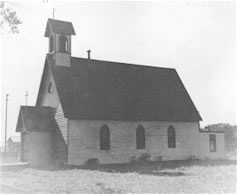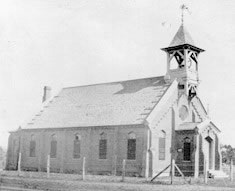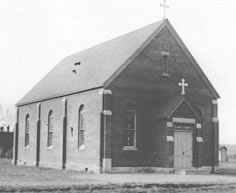Churches in Littleton
The development of Littleton's early churches is intertwined with the history of the town. Richard and Angeline Little, Episcopalians from New England, settled in the South Platte Valley in 1862. As more families arrived and Little established the successful Rough and Ready Mill which employed a number of workers, the need for schools and churches became apparent. Both Episcopalian and Methodist traveling clergy ventured out from Denver by horse and buggy to hold occasional services in family homes.

St. Paul's Episcopal Church, 1908.
In 1871 St. Paul's Episcopal Church, was built and consecrated. Richard Little had provided most of the money for the small frame building with belfry and high-pitched roof so reminiscent of New England. He also built it on his own land. The following year (1872) he platted the town of Littleton, and the cross streets where the church sat became Rapp (named for a friend) and Church. A few years later he deeded the lots, plus lots for a rectory, to the Episcopal Bishop.
Leaders in St. Paul's Church became leaders in the new community: F. B. Crocker, Charles E. Hill, Samuel T. Culp, H. H. Curtis, Ebenezer Jull. A Ladies Guild was soon formed and, in all reality, kept the church afloat with its apron and bake sales and "socials" that raised money to pay the coal and light bills, the janitor, repair to the buildings, sometimes the pastor's salary. Probably many of the same women were part of the Littleton Woman's Club which pushed for a library in the 1890s. Martha Crocker was the first librarian.

First Reformed Episcopal Church, c.1885.
A rift developed in this church in 1874 which resulted in a new congregation of Reformed Episcopalians (possibly the first one in America.) Richard Little generously gave them lots on Main Street for their new church. There, at the corner of Curtice Street, they erected the "Brick Church at Littleton" which became a landmark for miles around. John G. Lilley and Joseph W. Bowles were two prominent residents who led the new church. This denomination faltered after a few years, and the brick church was sold to the Presbyterians who had organized here in 1883.
The Methodists organized in 1890 with Victorine (Mrs. John) Mackey, Julia Cozens (wife of local carpenter Clark Cozens), school superintendent M. E. Eagleton, and others as charter members. Soon joining them were Lorena (Bair) and Charles G. Louthan, local builder, the Clyde and John Hoskin families, blacksmiths, and John Shadwell. They located their church on Nevada, just north of Main Street.
Meanwhile, the Episcopalians suffered another split when their priest left in 1892 and formed the People's Congregational Church. They built a red brick church on Alamo between Curtice and Nevada street which still stands. John G. Lilley became one of their trustees.

St. Mary's Catholic Church, 1903.
St. Mary's Catholic Church was built on land and with money given by Joseph W. Bowles at Nevada and High (now Powers) streets in 1901. It served area Catholics, no doubt including New Mexicans who had come north to work in truck farms along the river. The James Maloney family were some of St. Mary's leading members. Maloney was mayor of Littleton from 1910 to 1912 and from 1913 to 1919.
When the campaign raged to make Littleton the permanent Arapahoe County seat in 1904, a local publisher pictured the five churches (Episcopal, Methodist, Presbyterian, Catholic, and Congregational) to show what a fine community Littleton offered.
As the Episcopalians had dominated the local scene in the late 1800s, the Presbyterians seemed to become most influential during the new century. Some of this may have been due to dynamic pastors such as Dr. George Edmundson who took an active part in community life and served on the library board when the new Carnegie Library was built. Member Harry Nutting was partner with Ed and William Sterne in the Bank of Littleton and the Littleton Lumber Company. The relationship was so close that the Presbyterians stored valuable papers in the lumber company's safe. Others prominent in the community were Rupert Nutting, school superintendent Walter Ficklin, Dr. W. C. Crysler, Dr. William Flint, Judge Henry Teller, J. H. Ayers. Pioneers Robert Herrick and Edward Chatfield had been among the founders.

First Methodist Episcopal Church, c.1944.
Among the Methodists, Mrs. Bertha (Booth) Hoskin was a long-time Littleton teacher. Allen E. Bradley arrived in 1929 as superintendent of schools. During World War II, the Methodists arranged for children of Japanese truck farmers to be taught language classes in their church, and a Japanese Methodist Youth Fellowship was formed. Kindly George Bancroft owned grocery stores in various downtown locations for many years and gave away more food to needy folks than anyone ever knew. When he died in 1945 his legacy to the Methodists gave them the seed money to build their new church in Windermere Park. The Revs. Monfort "Monty" Jackson and William Persons were two Methodist ministers named Littleton's Most Valuable Citizen.
A well-known St. Mary's parishioner was Bill Bolis, for years the owner of Bolis Greenhouse in downtown Littleton. In 1950 the William Heckethorn family, owner of Heckethorn Manufacturing, gave land for St. Mary's new parish hall.
From the late forties to 1965 Dr. Russell "Rusty" Chandler was the Presbyterian pastor. Only one of the many community projects he spearheaded was the formation of Friendship House, a home for displaced refugees which was constructed with city-wide support on the current site of Arapahoe Community College.
Each of the churches sponsored boy scout troops, some begun as early as the twenties.
When new church buildings or additions were needed, the townspeople and merchants, whether members of that congregation or not, supported the efforts, often financially. Such projects were considered a benefit to the whole community. This account covers the role of Littleton's churches only to about 1950. They continue to contribute to their community and to its history.
Bibliography
Church of Saint Mary. 75 In '76: St. Mary's Of Littleton [Colorado] Diamond Jubilee. Littleton Colo.: Church of Saint Mary, 1976.
Hulse, Doris Farmer. "A History Of the First Presbyterian Church Of Littleton, Colorado, 1883-1995" in First Presbyterian Church Of Littleton, Colorado. Littleton, Colorado, Church Records, Volume I. Littleton, Colo.: Columbine Genealogical and Historical Society, 1995.
____. "A History Of Littleton United Methodist Church, 1890-1996" in Littleton United Methodist Church Of Littleton, Colorado. Littleton, Colorado, Church Records, Volume III. Littleton, Colo.: Columbine Genealogical and Historical Society, 1997.
____. "A History Of St. Paul's Episcopal Church, 1870-1919, and St. Timothy's Episcopal Church, 1951-1996, Of Littleton, Colorado" in St. Paul's Episcopal Church and St. Timothy's Episcopal Church Of Littleton, Colorado, Volume II. Littleton, Colo.: Columbine Genealogical and Historical Society, 1996.
Photographs courtesy of the Littleton Museum unless otherwise noted. To order copies, contact the museum at 303-795-3950.
Compiled by Doris Farmer Hulse
Updated April 2021 by Phyllis Larison